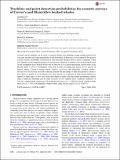Trackline and point detection probabilities for acoustic surveys of Cuvier’s and Blainville’s beaked whales
Abstract
Acoustic survey methods can be used to estimate density and abundance using sounds produced by cetaceans and detected using hydrophones if the probability of detection can be estimated. For passive acoustic surveys, probability of detection at zero horizontal distance from a sensor, commonly called g(0), depends on the temporal patterns of vocalizations. Methods to estimate g(0) are developed based on the assumption that a beaked whale will be detected if it is producing regular echolocation clicks directly under or above a hydrophone. Data from acoustic recording tags placed on two species of beaked whales (Cuvier’s beaked whale—Ziphius cavirostris and Blainville’s beaked whale—Mesoplodon densirostris) are used to directly estimate the percentage of time they produce echolocation clicks. A model of vocal behavior for these species as a function of their diving behavior is applied to other types of dive data (from time-depth recorders and time-depth-transmitting satellite tags) to indirectly determine g(0) in other locations for low ambient noise conditions. Estimates of g(0) for a single instant in time are 0.28 [standard deviation (s.d.) ¼ 0.05] for Cuvier’s beaked whale and 0.19 (s.d. ¼ 0.01) for Blainville’s beaked whale.
Citation
Barlow , J , Tyack , P L , Johnson , M J , Baird , R W , Schorr , G S , Andrews , R D & de Soto , N A 2013 , ' Trackline and point detection probabilities for acoustic surveys of Cuvier’s and Blainville’s beaked whales ' , Journal of the Acoustical Society of America , vol. 134 , no. 3 , pp. 2486-2496 . https://doi.org/10.1121/1.4816573
Publication
Journal of the Acoustical Society of America
Status
Peer reviewed
ISSN
0001-4966Type
Journal article
Collections
Items in the St Andrews Research Repository are protected by copyright, with all rights reserved, unless otherwise indicated.

